FWCM 10: Force Magnus is back!
What a World Championship Match this is! Karjakin leads with a point's advantage until game nine. Now Magnus fights back and equalizes the score with a victory in the tenth game! With just two classical encounters left, it could be anyone's Match. Wesley So has annotated the game for the readers of ChessBase. His analyses are so deep and insightful that we have not only published them here, but we have also made sure to give you diagrams of the key positions along with Wesley's explanations so that you know what a fellow super GM thinks about the positions.
Photos by Albert Silver
FWCM 10: Magnus Carlsen equalizes the score!
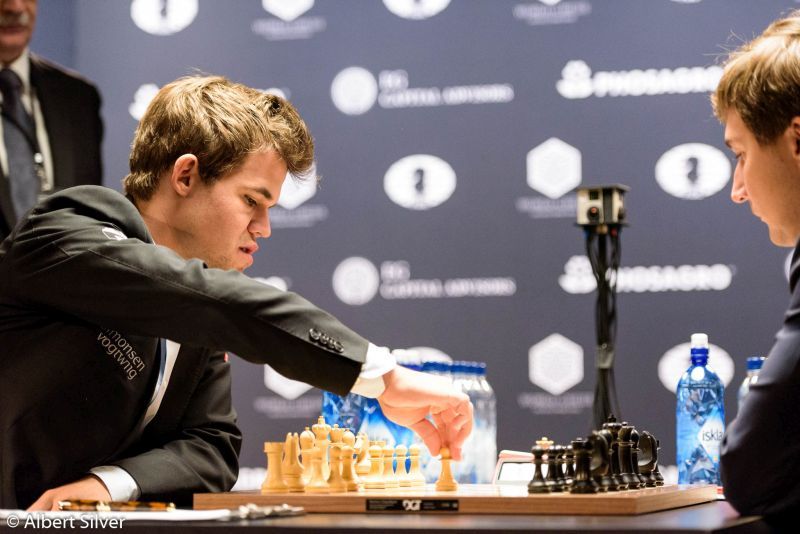
The game was huge and filled with interesting moments. Just as I sat down to analyze tenth game of the match, I realized that Wesley So has annotated it for the ChessBase newspage. And what a fantastic job he has done. So rather than trying to analyze the game all over again from my point of view, I am going to republish Wesley's analysis here.
But I would like to point out some very interesting moments from Wesley's analysis which only a world class player can understand.
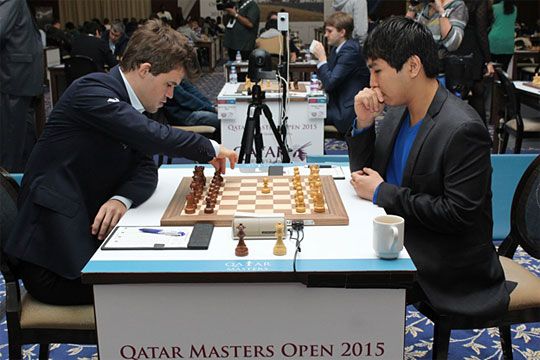
Wesley So's explanations
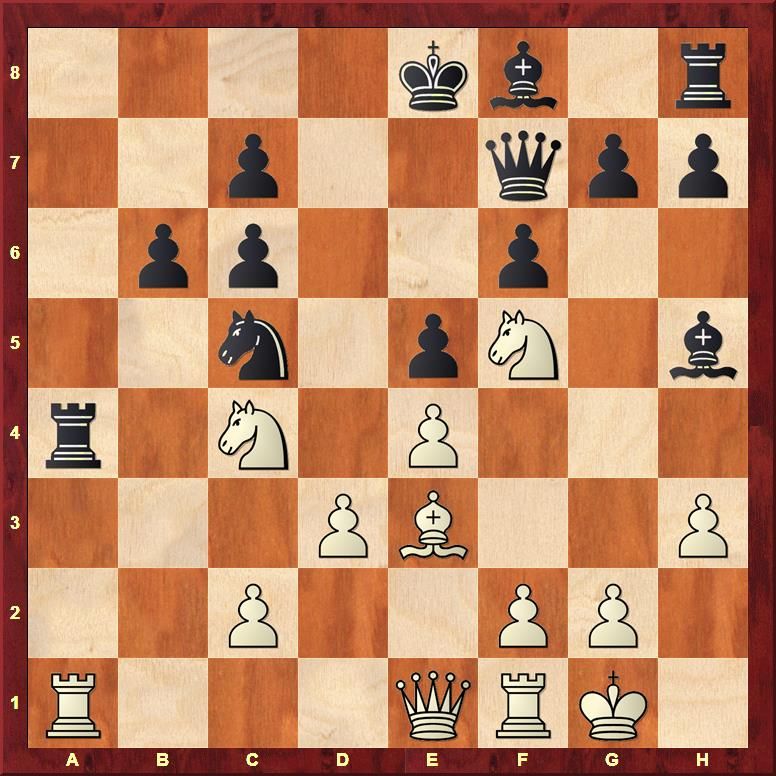
In the variation to move five Wesley's analysis reaches this position and he writes "And White won easily in Carlsen- against strong GM 1-0." And who is the strong GM? None other than Wesley So!
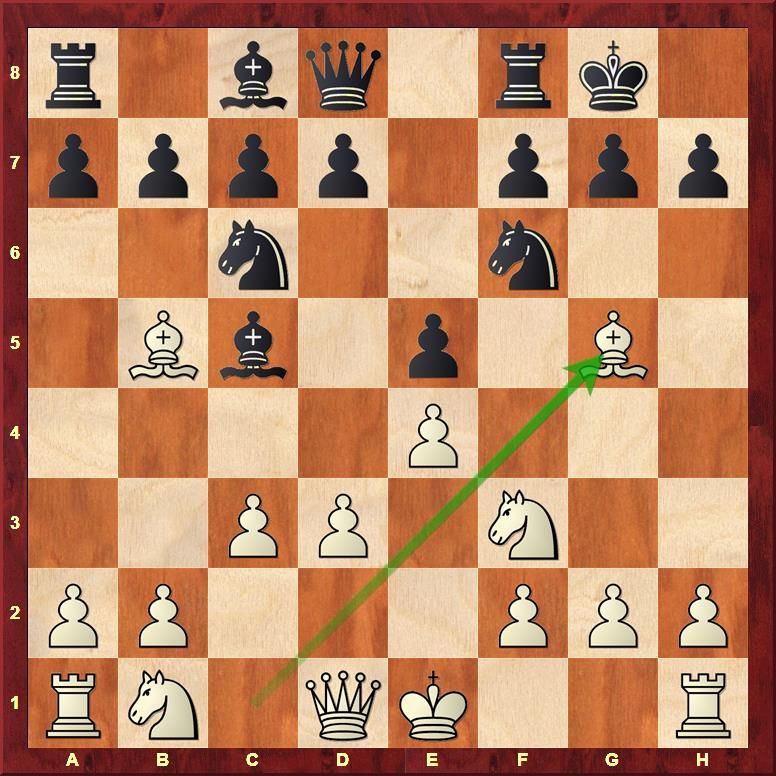
"This is unexpected, both for the spectators and I assume for Sergey too. Usually White castles his king first with 6.O-O and then after 6...d6 7.Bg5, when Black no longer has the option of Be7."
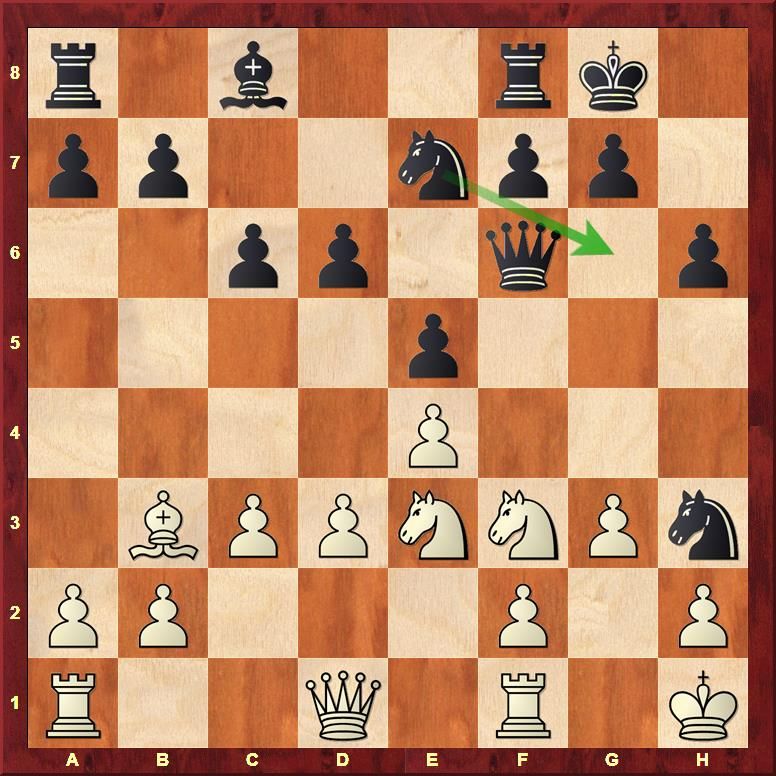
This is unexpected, both for the spectators and I assume for Sergey too. Usually White castles his king first with 6.O-O and then after 6...d6 7.Bg5, when Black no longer has the option of Be7.

"Ng6 is perhaps a small inaccuracy. The knight was just fine on e7, to guard the d5 and f5-squares. In fact Black has on his agenda an active option here to try to seize the initiative with ...d5!"
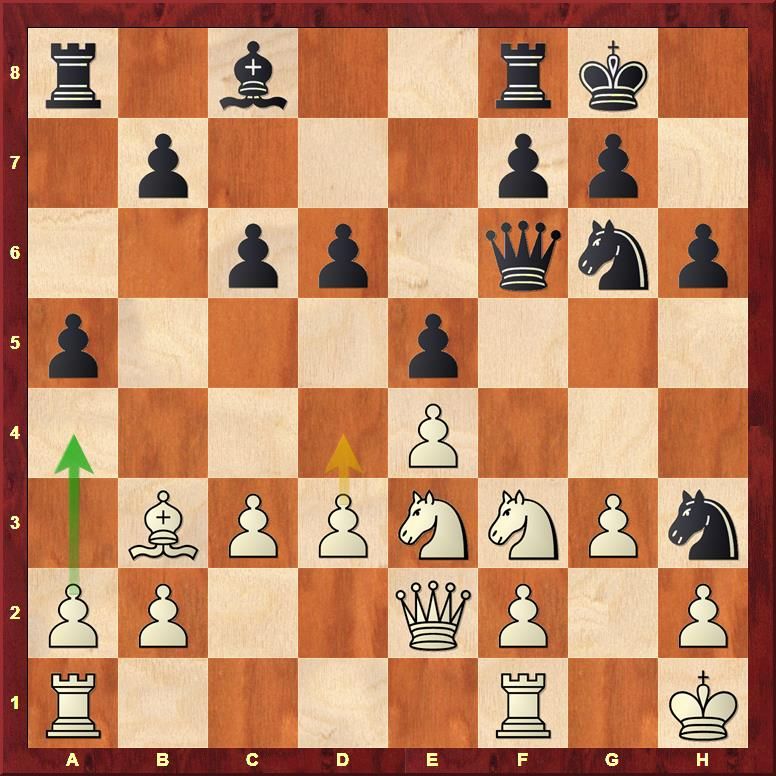
"Watching the game live, I thought stronger was 18.d4 based on the chess principle 'Attack on the flank is best met by a counter-attack in the center'."
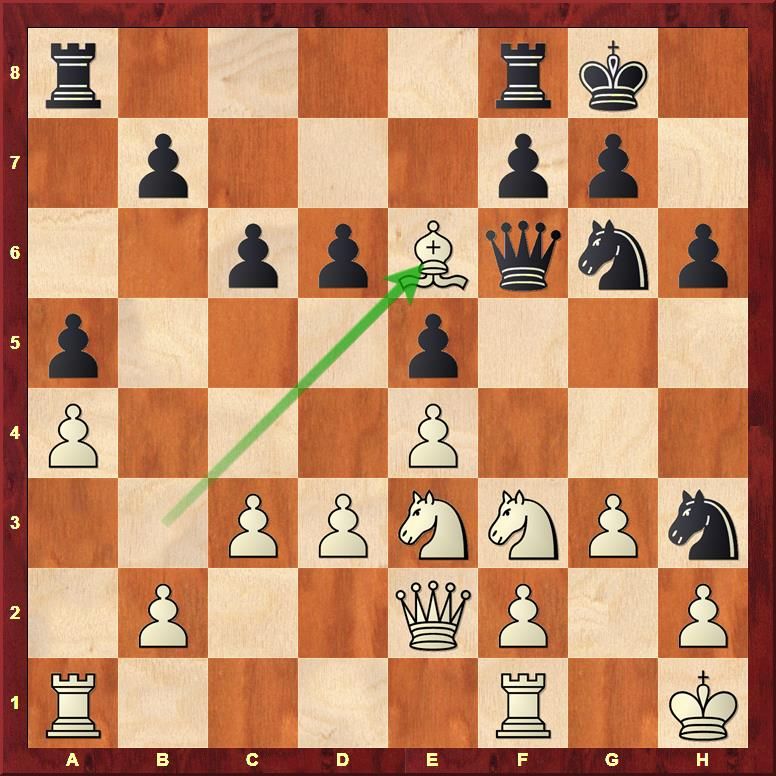
"When I first saw this move I thought Magnus just made a small blunder. I thought that's it, he just wasted one of his last White games, congrats to Sergey for making an easy draw and getting one step closer to being a World Champion. However deeper inspection shows that he sets up a trap!"
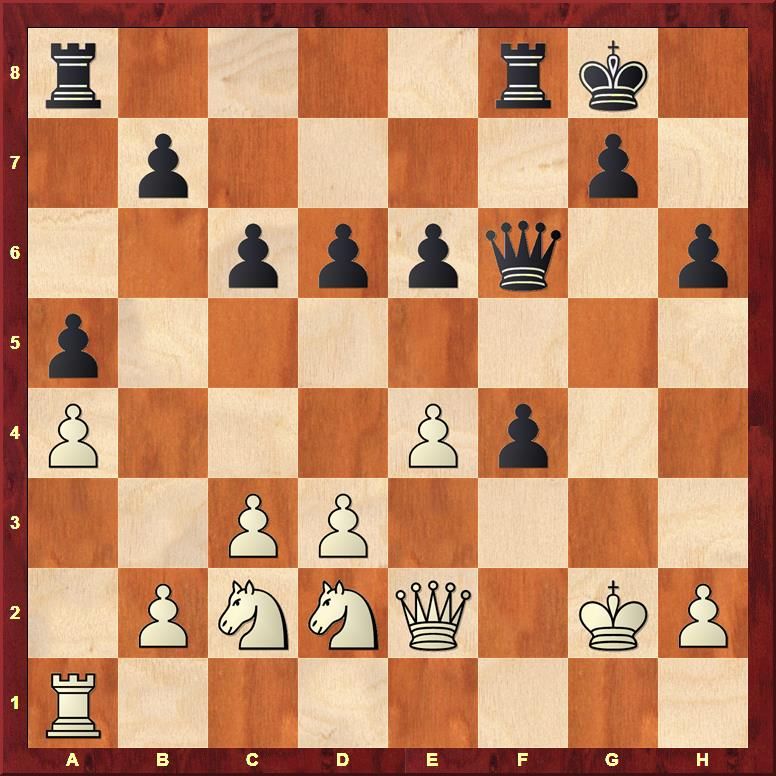
After 20...Nxf2+ complications many commentators reached this position. But Wesley dug deeper. He showed the various options at White's disposal to blockade the pawns with his knight.
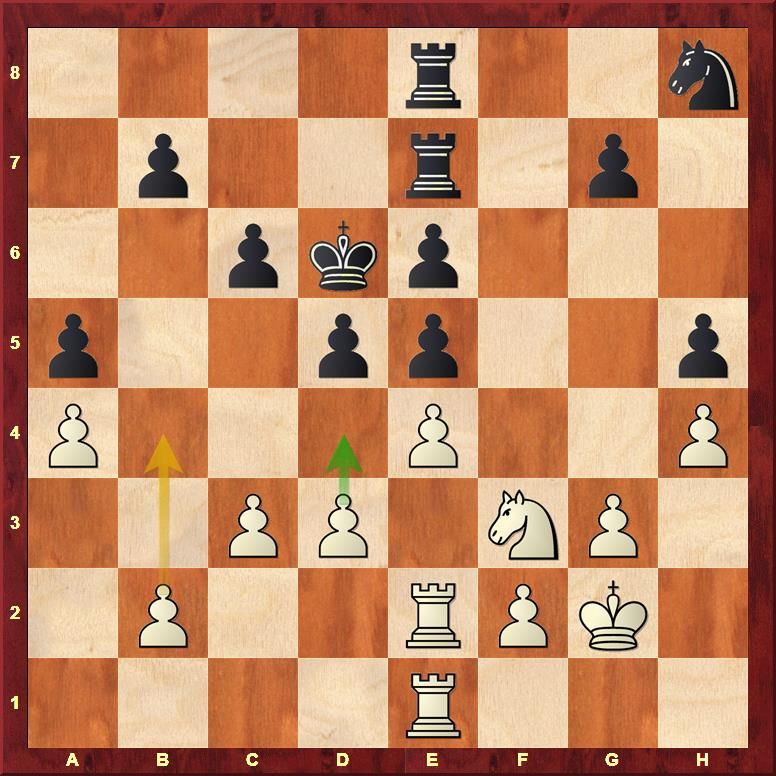
Magnus played the move 34.d4, but Wesley says that if he had the same position he would have gone for 34.b4. He also explains the reasons why he would have chosen that move.
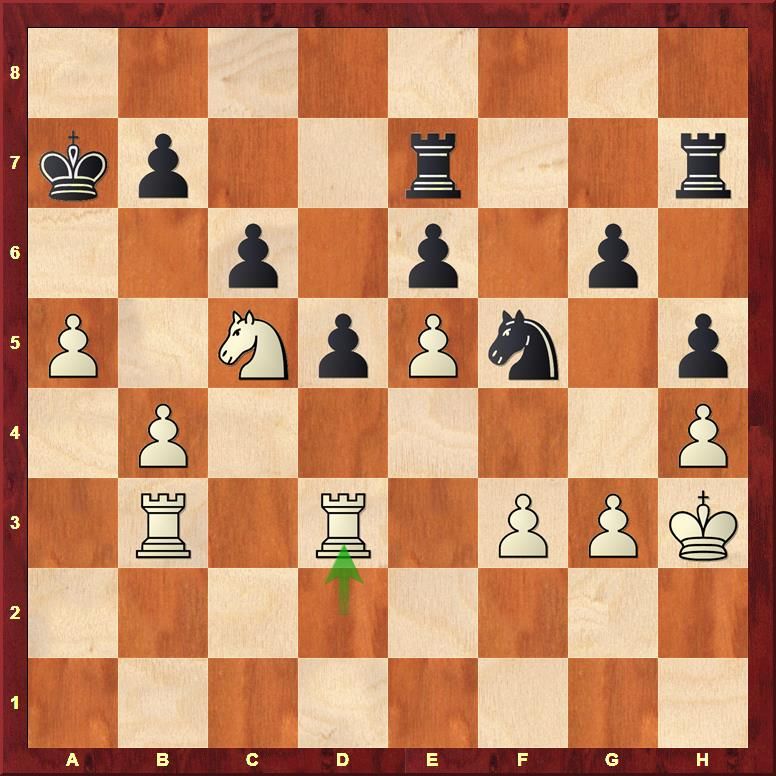
This is one of Magnus' favorite strategies. He likes to wait patiently for his opponent to crack while slowly improving his own position. This worked well for him today. But objectively now is the time to strike with 55.b5!
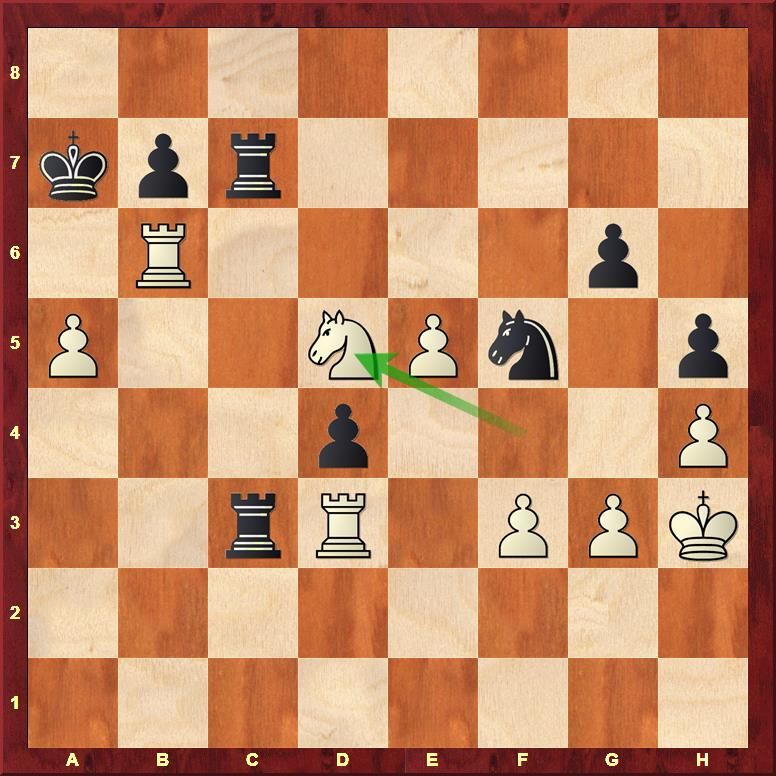
"Simplification makes White's job easier. The rule of thumb is that when you are ahead in material you aim for trades and exchanges. Like in soccer, 11 players vs 10 players is harder than 5 players vs 4 players, and a 3 vs 2 game is a piece of cake. Chess is no different. When you are ahead in material, exchanges usually mean less complications = cleaner win."
Wesley So's conclusion:
Magnus finally levels the match! This has been a great game and a great fight by both players. After choosing a modest line against the Berlin Opening, Magnus slowly improved his position and kept the game going. Black's knight looked a little shaky on h3 (perhaps 11...f5!?) and White managed to take advantage of this. The sequence from move 19-21 seems to me a little strange as Black allowed doubled-pawns and White gladly went for it and both sides developed interesting options. Perhaps 21...Ng5 was a crucial mistake as Sergey could maybe have made a draw with 21...Nxf2. But of course sitting at home, its much easier to calculate than it was for the two fighters in New York. Having played nine long games in two weeks with all the attendant pressure, tension and drama, most certainly took a toll on both players. A World Championship match definitely requires levels of extraordinary endurance for anyone. Looking ahead with the score 5-5 I feel Magnus has good chances now in the match. He absolutely had to win today and he did. Tomorrow is a rest day, so both players can relax and prepare new ideas. I'm sure Sergey will try to put on the pressure in Round 11 and fight for a win with the White pieces (in Round 9 he got close!) In case the match ends with two draws and a tie of 6-6 ensues, both players go to the tiebreaks with a shorter time control. Magnus may have the edge there although Sergey never fails to impress and surprise his fans.
Read the analysis below and learn from Wesley So:
[Site "New York"]
[Date "2016.11.24"]
[Round "?"]
[White "Carlsen, Magnus"]
[Black "Karjakin, Sergey"]
[Result "*"]
[ECO "C65"]
[WhiteElo "2853"]
[BlackElo "2772"]
[PlyCount "149"]
[EventDate "2016.??.??"]
logically considered Magnus to be the clear favorite against Sergey Karjakin.
First of all the difference in their rating was a bit wide, as was their most
recent overall performance.This year alone Magnus has won four big tournaments
(Tata Steel, Norway, Leuven and Bilbao), while Sergey had only won the
(admittedly long and tough) Candidates tournament which qualified him as the
Challenger. Those things carry weight in people's minds but rounds 1-9 showed
a different and very surprising story. The Challenger's strong balanced attack,
his ability to find good moves and make plans, his outstanding defense, and
resistance to cracking under pressure, proved him to be an impregnable
fortress. Magnus could not find a way to break Sergey down until eventually,
overextending himself in Round 8, the Champion even had to accept defeat. At
this point in Game 10 with only 3 games to the finish he absolutely has to
find a way to even the score. He HAS to do it today.} 1. e4 {In Rounds 1 and 8
Magnus got nowhere with 1.d4, after giving the Trompovsky and the Colle system
a try. Sergey Karjakin knew his stuff there. In fact he got nothing but
trouble in game 8. So today Magnus decides to go back to the "best by test
move" recommended by Fischer and Caruana. To be honest I'm kind of surprised
that Magnus does not try 1.c4 or 1.Nf3/1.g3 but maybe we will see that in
Round 12.} e5 2. Nf3 Nc6 3. Bb5 (3. Bc4 Bc5 {was Carlsen-Karjakin Round 5, but
Magnus got nothing there either and in the end he must have been happy to save
that game.}) 3... Nf6 {Sergey sticks to his guns and goes for the Berlin
Opening. I noticed that during the entire match so far, one of Sergey's
strategies has been simply to go for the main lines in the opening and play a
normal game. He does not overpush but maintains composure by playing objective,
strong moves.} 4. d3 {Magnus' strategy seemed mostly aimed at surprises in the
opening and later on, hopes to exploit his opponent's mistakes over the board.
It reminded me of a quote by a famous chess player: "I will play 40 good moves.
If my opponent plays 40 good moves too, we will draw." The problem in this
match is Sergey is the opponent who finds all the good moves too.} (4. O-O Nxe4
5. Re1 {was Carlsen-Karjakin Round 3, where White got very close to first
blood, but later on couldn't convert.}) 4... Bc5 {Putting the bishop on an
active post while also preparing to exchange the knights with Nd4.} 5. c3 ({
Magnus has won many games in the past with} 5. Bxc6 dxc6 {And here White has
many moves, but the latest innovation is} 6. Qe2 {threatening to take Nxe5.}
Qe7 (6... Bg4 7. h3 Bxf3 8. Qxf3 $14) 7. Nbd2 Bg4 8. h3 Bh5 9. a3 Nd7 10. b4
Bd6 11. Nc4 f6 12. Ne3 a5 13. Nf5 {The knight on f5 is very powerful and not
easy to dislodge.} Qf8 14. bxa5 Rxa5 15. O-O Qf7 16. a4 Nc5 (16... O-O $2 17.
Bh6 $1 {is a really nice combination.}) 17. Qe1 b6 18. Nd2 Rxa4 19. Nc4 Bf8 $2
20. Be3 {And White won easily Carlsen- against strong GM 1-0.}) 5... O-O 6. Bg5
{This is unexpected, both for the spectators and I assume for Sergey too.
Usually White castles his king first with 6.O-O and then after 6...d6 7.Bg5,
when Black no longer has the option of Be7.} (6. Bxc6 {does not win a clean
pawn, since after} bxc6 7. Nxe5 d5 {Black will get fast development in return.}
) 6... h6 7. Bh4 Be7 {This is the safe and natural approach. I like this move.}
(7... g5 8. Bg3 d6 9. Nbd2 {is not desirable for Black as with the rook still
on h1, White gets extra attacking options.}) 8. O-O (8. Bxc6 bxc6 9. Nxe5 {
You think White has won a pawn? Well...} Nxe4 $1 {No. Black is better.}) 8...
d6 9. Nbd2 {It's a little perplexing in general Magnus' opening approach, as
its not very clear here where White's advantage is.} ({Perhaps} 9. Bg3 {
with a complex position for example,} Nh5 ({If} 9... Bd7 {then} 10. h3 {
which is a typical Ruy Lopez subtlety, vacating the h2-square for the bishop
to retreat into!} Nh5 11. Bh2 f5 $13) 10. Bxc6 bxc6 (10... Nxg3 11. Bxb7 $1 {
Aha! The suicidal bishop gives up it's life so White wins a pawn.} Bxb7 12.
hxg3 $16) 11. Nxe5 dxe5 12. Qxh5 Qxd3 13. Qxe5 Re8 {and Black has the bishop
pair and some compensation for the pawn.}) (9. Re1 Nh5 10. Bxe7 Qxe7 11. d4 Nf4
$11) 9... Nh5 10. Bxe7 ({If} 10. Bg3 {Black just grabs the bishop pair:} Nxg3
11. hxg3 Bf6 {with a happy position.} (11... Nb8 12. d4 c6 13. Bd3 Nd7 14. Nc4
Qc7 {should also bring a smile to Sergey's face.})) 10... Qxe7 11. Nc4 (11.
Bxc6 {to give Black doubled pawns looks like a good option.} bxc6 12. d4 (12.
g3 f5) 12... Nf4 {But in fact White cannot really exploit it. In fact if
anything, the strong knight on f4 gives Black good chances. For example} 13.
Qa4 Rb8 14. b3 Rb6 $17 {when Black seizes a strong initiative. I can already
foresee a rook swing (Rb6-g6) to the kingside later on.}) 11... Nf4 {Simple
and strong.} (11... f5 {is a more complicated way to equality.} 12. Ne3 fxe4
13. dxe4 Kh7 $11) 12. Ne3 Qf6 (12... f5 {is always an option here, though after
} 13. g3 fxe4 14. dxe4 Nh3+ 15. Kg2 {the knight on h3 still has to find a way
to escape.}) 13. g3 Nh3+ 14. Kh1 {A little too passive.} ({The king would be
better placed on g2.} 14. Kg2 Ne7 15. d4 {gives White a small advantage as he
has more space and seizes control over the center.} Ng6 16. Bd3 {the knight on
h3 can be kicked later with Ng1.}) 14... Ne7 {Now comes the manoevering phase.
Both sides will now try to improve their position. The knight on h3 is very
active, and Black can always exchange it with Ng5. I think Black has no
problems here.} 15. Bc4 {Putting the bishop on the right diagonal.} (15. d4 {
seems natural but leads nowhere.} exd4 16. cxd4 c5 $11) 15... c6 (15... b5 {
was being cried out by the spectators online:} 16. Bb3 {But I am not sure
where it leads. Advancing pawns too far can lead to unnecessary weaknesses and
as everyone knows pawns cannot move backwards. In fact White is threatening
a2-a4 so perhaps} (16. Bxb5 Rb8) 16... Rb8 {with around equal position.}) 16.
Bb3 Ng6 {Perhaps a small inaccuracy.} ({The knight was just fine on e7, to
guard the d5 and f5-squares. In fact Black has on his agenda an active option
here to try to seize the initiative:} 16... d5 $5 17. exd5 cxd5 18. Nxd5 Nxd5
19. Bxd5 Rd8 20. Be4 {and now comes The Pin:} Bg4 $1 {And White has to
sacrifice material to get rid of this dangerous pin.}) 17. Qe2 {I always think
Magnus excels in this kind of close to equal positions. So in fact his opening
choice has been quite successful despite its modest appearance. Now even if
the advantage is not much, White has chances to outplay his opponent.} a5 18.
a4 {Fighting for space on the queenside and fixing the pawn on a5. With the
black knights so far away on the kingside, later this a5 pawn will lack
protection.} ({Watching the game live, I thought stronger was} 18. d4 {based
on the chess principle 'Attack on the flank is best met by a counter-attack in
the center'.} a4 19. Bc2 Ng5 20. Nxg5 hxg5 21. Rad1 {and White is a little
better. But now I like Magnus choice too, as he wants to dominate the whole
board, and not just the center.}) 18... Be6 19. Bxe6 $5 {When I first saw this
move I thought Magnus just made a small blunder. I thought that's it, he just
wasted one of his last White games, congrats to Sergey for making an easy draw
and getting one step closer to being a World Champion. However deeper
inspection shows that he sets up a trap!} (19. Nd2 $1 {is definitely the best
move. Black's knights on g6 and h3 look nice, but in fact they're stepping on
each other's shoes as none of them can really put a foot on f4, while White is
ready to consolidate his center with f3.} Bxb3 20. Nxb3 {and in fact White is
already threatening to win a pawn with Nc4, amongst other threats.} Ng5 21. f3
{White has a much better coordination of pieces than his opponent's.}) (19. Bc2
Ng5 20. Nxg5 hxg5 21. Rad1 {is possible too, though not as forceful as 19.Nd2.}
) 19... fxe6 20. Nd2 {Now White is threatening to block the kingside with f3.}
d5 ({I thought 19.Bxe6 was a blunder because at first sight} 20... Nxf2+ {
seems to finish the game with a clean draw. But Magnus still has a final trick
up his sleeve which I am sure he will go for.} 21. Kg1 $1 {is the prepared
trick. Now White gets two knights for a rook and a couple of pawns.} (21. Kg2
$2 Nh4+ 22. Kg1 (22. gxh4 $2 Qg6+ {will end the match right here and right
there.}) 22... Nh3+ 23. Kh1 Nf2+ {and a perpetual check is undesirable for
White, as he trails the match.}) 21... Nh3+ 22. Kg2 Nhf4+ 23. gxf4 Nxf4+ 24.
Rxf4 exf4 (24... Qxf4 25. Qf3 $1 {gives Black an unpleasant choice. To trade
queens or not to trade? Either way White will be happy.} Qh4 26. Qg3) 25. Nc2 {
In terms of material Black is fine, but with the position being closed, the
White knights get a lot of jumping potential. Leading the match by one game,
Sergey decides to avoid unbalanced positions like this.} e5 ({Perhaps} 25... b5
{to open some files but then} 26. e5 $1 dxe5 27. Ne1 $5 {with the idea to
blockade with the knights on e4 and f3. The position is totally chaotic.}) 26.
Qg4 {and White is preparing to improve his kingside with h4 or Ne1-f3. At the
very least he is not worse and could even be better.}) 21. Qh5 $5 {Again a
very daring try by Magnus. He goes for the most risky but most rewarding
continuation.} (21. f3 $1 {would be my preference. White is well on his way to
consolidation. Knight sacrifices on f4 do not work, while the doubled e-pawns
give Black eternal problems.} Rad8 22. Rae1 {I like White.}) 21... Ng5 {
Sergey misses the draw! Just when he is close to it, he chooses another way.} (
21... Nxf2+ 22. Kg2 (22. Kg1 Qg5 {wins a pawn with an easy tactic.} 23. Qxg5
Nh3+ {Check!} 24. Kg2 Nxg5 $17) 22... Qf7 $1 {Threatening Nf4 check.} 23. Kg1 {
White prevents the check, and now Black has to find:} ({If White retreats with
} 23. Qe2 {then} Nh4+ {and its clear to see that it leads to a perpetual.} 24.
Kg1 (24. gxh4 $2 Qg6+) 24... Nh3+ 25. Kh1 Nf2+) 23... Qf6 $1 {It's easy to
miss this move. Black prepares Qg5 followed by Nh3 check, so White has nothing
better than} 24. Kg2 (24. Ng4 Qg5) 24... Qf7 $11) 22. h4 {Magnus is so happy
to be able to torture his opponent in a long endgame that he just went for it.
According to online sources he spent less than half a minute on this move.} ({
I don't blame him at all for wanting to squeeze the life out of Sergey in the
endgame but} 22. Rae1 $1 {preparing Ng4, is even stronger. For example} Nf3 23.
Ng4 Qg5 24. Qxg5 hxg5 25. Nxf3 Rxf3 26. Rd1 $16 {You may ask, what is worse
than doubled pawns? Well... four doubled-pawns.}) 22... Nf3 23. Nxf3 Qxf3+ 24.
Qxf3 Rxf3 25. Kg2 {Magnus daring play starting from 19.Bxe6 has paid off.
White has a very pleasant endgame advantage. The doubled e-pawns are a
constant source of problems. I don't like Black's position.} Rf7 26. Rfe1 {
This leaves the f2-pawn slightly vulnerable. Not that it matters though. White
has an abundance of plans here.} ({I like} 26. Ng4 {Forcing h5.} h5 27. Nh2 Nf8
28. Nf3 {Now White seizes the g5-square too.} Nd7 29. Rae1 {White is well on
the way to converting his advantage.}) 26... h5 (26... Raf8 {can be simply met
by} 27. Nd1 (27. Re2 {gives birth to} Nf4+ {ideas.} 28. gxf4 exf4) 27... h5 28.
Re2 $14) 27. Nf1 {Finding ideal squares for his pieces is a piece of cake for
Magnus.} Kf8 (27... Raf8 28. Re2 Rf3 29. Rd1 {with the queens off the board
any tries by Black to attack will not be successful. So instead he tries to
improve his king.}) 28. Nd2 Ke7 29. Re2 {Protecting f2. This is a very happy
position. I had no doubt that White would be able to convert this position
barring big blunders. It's got nothing to do with Sergey, the Black structure
is simply bad.} Kd6 30. Nf3 Raf8 31. Ng5 Re7 32. Rae1 Rfe8 33. Nf3 {Besides
all Black problems, his knight is also a little misplaced on g6.} Nh8 $1 {
Improving the position of the knight. Despite being at a disadvantage, Sergey
hangs tough. The question for White now, is how to convert his advantage?} 34.
d4 {A conversion of advantages. Magnus decides the time is ripe to blast open
the center and endanger the position of the Black king.} ({Personally I would
prefer to leave Black with his doubled pawns and choose} 34. b4 axb4 35. cxb4
Nf7 36. a5 {with a clear advantage too, but sooner or later White has to find
a way to break through.}) 34... exd4 35. Nxd4 g6 {Protecting the f5-square.} ({
A lesser wood pusher might go} 35... Nf7 {but then} 36. exd5 cxd5 37. c4 dxc4 {
and the Black king is caught in the middle of the crossfire.}) 36. Re3 {
Threatening Rf3. Again White has an abundance of plans here. b2-b4 ideas are
always in the air.} ({I like the subtle} 36. Nb3 $5 b6 37. Nd4 {with the idea
of weakening c6 but perhaps its too subtle for the most part.}) 36... Nf7 37.
e5+ (37. Rf3 Ne5 38. Rf6 Rf7 {allows Black to defend no problemo. After the
exchange of his most active rook, White's chances to convert become much
harder.} 39. Rxf7 Nxf7) 37... Kd7 38. Rf3 {Perhaps not the best but it is a
normal move, especially when both players are relatively low in time.} (38. b4
{is more acurate, to prevent c5 ideas.}) 38... Nh6 $6 {Sergey also makes a
natural consolidating move. If he can block the f-file with Nf5, then all well
and good. However Black has better options here on move 38 though.} (38... c5 {
looks good, to set the queenside pawns into motion. After} 39. Nb3 b6 40. Nd2 {
Black still does not fully solve his problems however.} Nh8 $1 (40... Rg8 41.
Rf6 {and the g6-h5 pawn chain will be quite vulnerable.}) 41. c4 (41. Rf6 Rf7
$1 {eliminates White's most active piece!}) 41... Rf7 {the programs show that
Black is fine but it's hard for me to believe with the knight on h8. Also,
it's almost impossible for a human to play Nh8 over the board.}) (38... g5 39.
hxg5 Nxg5 40. Rf6) ({Or} 38... Rg8 39. Rf6 {but White still looks better here.}
) 39. Rf6 Rg7 40. b4 {Now White is back on track.} (40. c4 $5 {is the
complicated way to try to knock out Black. His king will be vulnerable in the
center even in the endgame.}) 40... axb4 41. cxb4 $16 {Both players have
finished the time trouble stage and now have an extra hour of thinking time.
Compared to a few moves back, White has now managed to increase his advantage
and gain firm control over the position. Black's dark-squares are very
vulnerable and at the same time he has to think of ways to regain control over
the f-file.} Ng8 ({If} 41... Nf5 {White simply retreats his knight to b3 or f3,
and the pressure becomes untenable in conjunction with a power rook on f6.})
42. Rf3 Nh6 43. a5 {Improving his position slowly but surely. Of course White
avoids the repetition of moves!} Nf5 44. Nb3 Kc7 45. Nc5 $6 {Magnus starts to
drift, probably because he has such a nice position.} ({White could have
sealed the win with} 45. Rc1 {threatening b5. And if} Kb8 46. a6 {if the b7-c6
pawn chain falls then the last of Black's bastions are fallen.} Rc7 47. Rfc3 {
A sample line of how the game can end:} bxa6 48. Rxc6 Rxc6 49. Rxc6 Kb7 50.
Na5+ Ka7 51. Rc7+ Kb8 52. Rf7 $18 {Seventh rank, active pieces, later on
active king, White has all the Trumps that he needs. Black's position is
crumbling.}) 45... Kb8 46. Rb1 Ka7 {Now there is no clean finish. However
White is still clearly ahead.} 47. Rd3 Rc7 ({Trying to counter with a punch is
too slow} 47... g5 48. hxg5 Rxg5 {After} 49. b5 $18 {Black cannot defend all
his weaknesses (b7 and e6).}) (47... b6 {can be met simply by} 48. Na4 ({
Or even better:} 48. axb6+ Kxb6 49. Ra3 Ra7 50. Rxa7 Kxa7 51. Kf3 $16 {when
the White king is really fast.})) 48. Ra3 Nd4 49. Rd1 Nf5 50. Kh3 Nh6 51. f3 {
White has improved the position of his king in the past few moves and is now
introducing the possibility of opening up the kingside with g4. Black can do
nothing but sit and wait.} Rf7 52. Rd4 Nf5 53. Rd2 ({I like} 53. Rf4 {but then}
Rh7 $1 {preventing g4, leaves the White rook immobile on f4.}) 53... Rh7 54.
Rb3 Ree7 55. Rdd3 {This is one of Magnus' favorite strategies. He likes to
wait patiently for his opponent to crack while slowly improving his own
position. This worked well for him today.} ({But objectively now is the time
to strike.} 55. b5 $1 cxb5 56. Rxb5 {Black cannot hold on to his b7 and
e6-pawn for long. Perhaps Black can try} Ne3 {but then} 57. Rd3 Nc4 58. f4 {
gives White all the time he needs to improve his position. Black rooks are
stuck defending pawns, which is never a good sign. Rooks are made for offense,
not defense!}) 55... Rh8 56. Rb1 {Again waiting for the right moment. Just
wait, just wait... Patience is a virtue.} Rhh7 57. b5 $1 {NOW!} cxb5 58. Rxb5 {
Compared to move 55, the only change is White rook is on d3. Notice the
difference? Black does not have Ne3-c4 now and his position crumbles quickly.}
d4 59. Rb6 Rc7 60. Nxe6 Rc3 61. Nf4 Rhc7 62. Nd5 $1 {Simplification makes
White's job easier. The rule of thumb is that when you are ahead in material
you aim for trades and exchanges. Like in soccer, 11 players vs 10 players is
harder than 5 players vs 4 players, and a 3 vs 2 game is a piece of cake.
Chess is no different. When you are ahead in material, exchanges usually mean
less complications = cleaner win.} (62. Rxg6 Rxd3 (62... Rc1 {gives White a
choice between five different moves that win.}) 63. Nxd3 Rc3 64. Rf6 Ne3 65.
Nf4 {and White's win should be easy. Contrary to appearances there is never
any mate on h1, as White can always free his king with g3-g4. Meanwhile White
is two pawns up.}) 62... Rxd3 63. Nxc7 {Some people didn't understand it at
first, however if you put this position in a super computer it just gives +- 5.
36, meaning White is more than five pawns up in a mathematical scale.} Kb8 64.
Nb5 Kc8 (64... Rxf3 65. a6 {promotes the passed a-pawn.}) 65. Rxg6 Rxf3 66. Kg2
$1 {Activating the king. From here Magnus does not give Sergey any chance to
escape.} Rb3 67. Nd6+ {Another exchange. Now it is 6 vs 5.} Nxd6 68. Rxd6 Re3
69. e6 ({Not} 69. Rxd4 $2 Rxe5 70. Ra4 Kd7 {when the Black king goes over to
the kingside and secures the draw. The rook on a4 has become a mere spectator
protecting the a-pawn.}) 69... Kc7 (69... d3 70. Kf2 $18) 70. Rxd4 Rxe6 (70...
Re5 $5 71. e7 $5 Rxe7 72. Rd5 {does not change anything.}) 71. Rd5 $1 {The
White rook attacks h5 while at the same time protecting his a-pawn.} Rh6 72.
Kf3 {Sergey could safely have resigned here, but it does not hurt to make a
few more moves. After all its not over until the king is mated.} Kb8 (72... b6
73. axb6+ Kxb6 74. Kf4 Kc6 75. Rd8 {White need not even calculate rook and
single pawn endings because he can win the enemy pawn by force.} Kc7 76. Rg8
Kd6 77. Kg5 Rh7 78. Kg6 $18) (72... Kc6 73. Rf5 Kd6 74. g4 hxg4+ 75. Kxg4 $18 {
also wins easily.}) 73. Kf4 (73. g4 hxg4+ 74. Kxg4 $18 {easy win.}) 73... Ka7
74. Kg5 Rh8 75. Kf6 {Magnus finally levels the match! This has been a great
game and a great fight by both players. After choosing a modest line against
the Berlin Opening, Magnus slowly improved his position and kept the game
going. Black's knight looked a little shaky on h3 (perhaps 11...f5!?) and
White managed to take advantage of this. The sequence from move 19-21 seems to
me a little strange as Black allowed doubled-pawns and White gladly went for
it and both sides developed interesting options. Perhaps 21...Ng5 was a
crucial mistake as Sergey could maybe have made a draw with 21...Nxf2. But of
course sitting at home, its much easier to calculate than it was for the two
fighters in New York. Having played nine long games in two weeks with all the
attendant pressure, tension and drama, most certainly took a toll on both
players. A World Championship match definitely requires levels of
extraordinary endurance for anyone. Looking ahead with the score 5-5 I feel
Magnus has good chances now in the match. He absolutely had to win today and
he did. Tomorrow is a rest day, so both players can relax and prepare new
ideas. I'm sure Sergey will try to put on the pressure in Round 11 and fight
for a win with the White pieces (in Round 9 he got close!) In case the match
ends with two draws and a tie of 6-6 ensues, both players go to the tiebreaks
with a shorter time control. Magnus may have the edge there although Sergey
never fails to impress and surprise his fans.} *

Tactical analysis in ChessBase 14
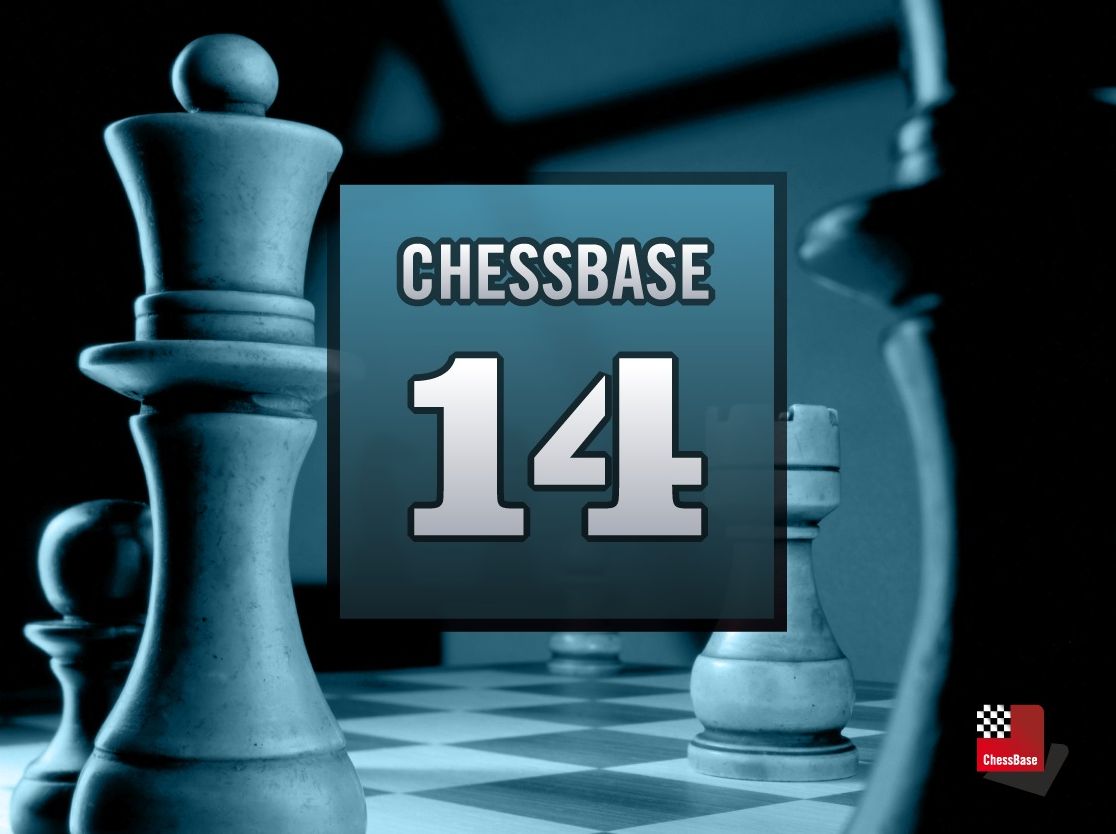
In ChessBase 14 all you need to do is open the game, go to the "Analysis" tab and select "Tactical Analysis". The only thing you must decide now is how much time would you like the engine to take per move. It starts from 1 second.
You have all the variations, text, and even training questions done by ChessBase 14 program. There was absolutely no human intervention.
(Maximize the board to full screen mode to enjoy the analysis)
This is not particularly detailed or comprehensive analysis, but it surely gives you a feel for the flow of the game.
The above special price is only for the Indian residents. Others can buy the ChessBase 14 download version from the ChessBase International Shop for 99.90 euros.
Related:
- FWCM 2016 09: Karjakin cements his lead
- FWCM 2016 08: Karjakin strikes the first blow
- FWCM 2016 07: Carlsen's carelessness
- FWCM 2016 06: A heavy theoretical battle
- FWCM 2016 05: A perfect draw!
- FWCM 2016 04: Slippery as an Eel
- FWCM 2016 03: A lively Berlin Endgame!
- FWCM 2016 02: Carlsen's mysterious rook moves
- FWCM 2016 01: Carlsen's benign Trumpowsky!
- FWCM 2016: Press Conference and Opening Ceremony
